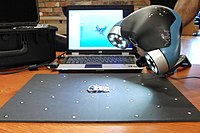
Photo from wikipedia
This work reports the modification and optimization of a computed tomography (CT) algorithm to become capable of resolving an optical field with internal optical blockage (IOB) present. The IOB-practically, the… Click to show full abstract
This work reports the modification and optimization of a computed tomography (CT) algorithm to become capable of resolving an optical field with internal optical blockage (IOB) present. The IOB-practically, the opaque mechanical parts installed inside the measurement domain-prevents a portion of emitted light from transmitting to optical sensors. Such blockage disrupts the line-of-sight intensity integration on recorded projections and eventually leads to incorrect reconstructions. In the modified algorithm developed in this work, the positions of the obstacle are measured a priori, and then the discretized optical fields (i.e., voxels) are classified as those that participate in the CT process (named effective voxels) and those that are expelled, based on the relative positions of the imaging sensors, IOB, and light signal distribution. Finally, the effective voxels can be iteratively reconstructed by combining their projections on sensors that provide direct observation. Moreover, the impact of IOB on reconstruction accuracy is discussed under different sensor arrangements to provide hands-on guidance on sensor orientation selection in practical CT problems. The modified algorithm and sensor arrangement strategy are both numerically and experimentally validated by simulated phantoms and a two-branch premixed laminar flame in this work.
Journal Title: Applied optics
Year Published: 2022
Link to full text (if available)
Share on Social Media: Sign Up to like & get
recommendations!